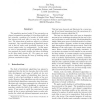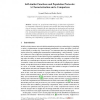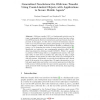254 search results - page 3 / 51 » Counting with Population Protocols |
105
Voted
FCSC
2008
15 years 21 days ago
2008
The population protocol model [2] has emerged as an elegant computation paradigm for describing mobile ad hoc networks, consisting of a number of mobile nodes that interact with e...
103
Voted
ICDCN
2009
Springer
15 years 7 months ago
2009
Springer
Chandy et al. proposed the methodology of “self-similar algorithms” for distributed computation in dynamic environments. We further characterize the class of functions computab...
WDAG
2007
Springer
15 years 6 months ago
2007
Springer
We describe and analyze a 3-state one-way population protocol to compute approximate majority in the model in which pairs of agents are drawn uniformly at random to interact. Given...
118
Voted
FC
2008
Springer
15 years 2 months ago
2008
Springer
Oblivious transfer (OT) is a fundamental primitive used in many cryptographic protocols, including general secure function evaluation (SFE) protocols. However, interaction is a pri...
CORR
2008
Springer
15 years 1 months ago
2008
Springer
Population protocols have been introduced as a model of sensor networks consisting of very limited mobile agents with no control over their own movement: A collection of anonymous ...



